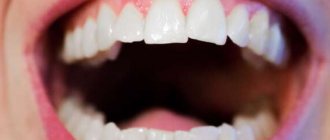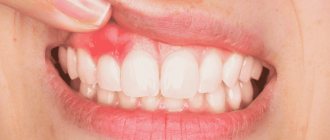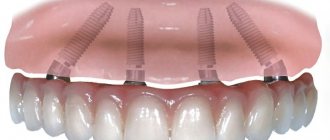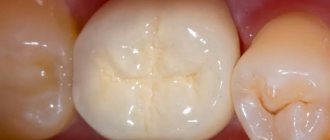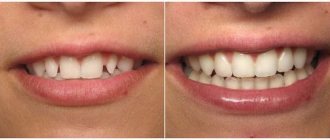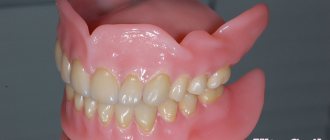A healthy tooth remains stable; slight fluctuation is acceptable due to the normal functioning of the periodontium. But the limits are minimal - no more than 100 microns. When pressed with your fingers, the vibrations are imperceptible and do not cause discomfort. But noticeable mobility indicates the development of a problem not only with the prosthesis, but also with the artificial root.
A dental implant is a complex structure for which the following types of prostheses are used:
- partially or completely removable;
- bridge-like permanents;
- fixed and conditionally removable crowns.
The implant consists of two elements:
- intraosseous part of conical-cylindrical, cylindrical, conical shape, perceiving loads;
- abutment as an intermediate link between the crown and the implant.
Damage to one of these elements or surrounding tissues leads to the fact that the dental system becomes loose and becomes mobile.
The ceramic lining on the crowns began to chip
The most likely cause is nocturnal bruxism. That is, in your sleep you clench your teeth and/or grind them uncontrollably. The reason for this is considered to be psychological stress.
Orthopedists often prescribe a night guard for these patients. Don't neglect her. It will cost money to have your teeth redone.
What to do? If you have these symptoms, your doctor will make a special night guard. It will need to be worn before bed to protect both the implants and teeth. At first it may cause slight discomfort.
Why do crowns fall off?
This unpleasant situation is caused by several reasons:
- Failure to comply with operating conditions when a person chews hard foods or gets carried away with viscous foods;
- Dental cement has become unusable;
- The crown has been worn out - the product has worn out and requires replacement;
- Mechanical injury;
- The crown is fixed with temporary cement and is not removed in a timely manner;
- Caries began under the crown of the tooth, breaking the tightness of the connection between the stump and the prosthesis;
- The crown does not match the ground tooth;
- Unsuitable prosthesis.
Implant maintenance has become too expensive for me
Once every six months, it is recommended to have your teeth and implants professionally cleaned by a hygienist. The procedure is not very expensive (3000-6000 rubles), and in many clinics it is a mandatory item in the warranty program for implants. If you don’t take care of your implants at all (as well as healthy teeth), the risk of problems and complications increases. What to do? If you do not have the opportunity to visit a hygienist, focus on self-hygiene - this is not such a costly procedure. Check out our recommendations:
How to provide first aid?
It is not always possible to go to see a doctor immediately. A crown may fall out when a person is on vacation or on a business trip. In this case, the visit to the doctor will have to be postponed for some time, but the aesthetics of the oral cavity will need to be restored urgently.
How to temporarily fix a crown without harming the oral cavity:
- Rinse the mouth thoroughly;
- Carefully place the crown in place - if this is successful, it may remain in place for some time;
- If this manipulation does not produce results, you should purchase dental cement at the pharmacy;
- Clean the crown and wipe dry;
- Clean the tooth from food debris;
- Apply the cement composition to the crown (only to the crown);
- Carefully place the product in place, press and hold;
- Remove excess cement using gauze.
This is a forced and temporary measure. This mount will only last a few days. During this time, you need to find an opportunity to see a dentist to solve the problem. Until this point, you can only eat soft foods.
You cannot use any non-medical methods of fixation (including folk remedies). Rough attempts will only make the problem worse.
Reasons why crowns fall out
Why does a dental crown come off? This may happen for the following reasons:
- poor-quality cementing composition: many patients believe that this is the primary reason. But the main purpose of cement is not so much to fix the orthopedic structure on the tooth (in a good way, it should “sit” on it very tightly even without the use of dental glue), but to seal the gap between the tooth’s own tissues and the prosthesis,
- errors during preparation: when preparing a tooth, removing a nerve, taking impressions (molds), when installing a pin or stump inlay,
- errors in the manufacture of an orthopedic structure: ideally, the inside of the prosthesis should exactly repeat the shape of the stump. The discrepancy between the internal cavity of the prosthesis and the shape of the ground tooth is the main reason why the dental crown flies off,
- the bite is broken: during the treatment process, occlusion must be taken into account1, since improper closure of the dentition can lead to chips in the enamel, as well as damage and peeling off of artificial structures on the teeth,
- the patient did not follow the rules for using dentures: excessive load from hard foods, poor oral hygiene, improper use of floss or the use of toothpicks - as a result, the cement inside crumbles, inflammation and neoplasms may appear under the roots,
- diseases of the oral cavity: gum recession (decrease in level) against the background of prolonged inflammation of the soft tissues exposes the tooth roots, and the denture no longer contacts the gum. Food can get stuck under it, especially if the cement along the contour begins to deteriorate - and as a result, caries develops,
- The service life of the structure has come to an end: for plastic “caps” it is 3 years, for metal-ceramic ones – 5-7 years, and for zirconium dioxide – from 20 years; temporary crowns can be worn for only a few months.
REPROSTHETOSIS WITH ACRYLIC PROSTHETICS - RUB 180,000!
Re-prosthetics with an acrylic bridge on a metal frame (all included) up to 12 units.
Call now or request a call
Why does the prosthesis fall?
Orthopedics is one of the most complex areas of dentistry. For high-quality installation of a prosthesis, in which the likelihood of the crown falling off is minimal, it is necessary to take into account many factors. The size of the lost fragment, individual characteristics of the bite, proper sanitation of the oral cavity before treatment, correct calculation of height - the surgeon must take these and other aspects into account when making prosthetics. A dental bridge is a thin and rather fragile product, especially when made from ceramics. It has increased whiteness and remarkable aesthetic qualities, but, according to statistics, most often it happens that a ceramic crown comes off. The geometry of the turning of the element is of great importance: the more parallel the walls are (the less taper), the lower the likelihood of going to the doctor because the crown has fallen off. Among other reasons for force majeure, the following factors should be noted.
- External influence, for example, sharp pressure when eating solid food. You need to be very careful when biting into apples or chewing nuts with dentures in your mouth.
- Mechanical damage due to injury or impact. This can happen when playing sports or moving awkwardly.
- Low-grade cement that cracks and crumbles over time. You need to use only high-quality mixtures from the world's leading manufacturers.
- Insufficient sanitation of the oral cavity. If saliva or a particle of food remains under the denture, it is possible that the problem of “crown falling off” will soon become urgent.
- Incorrectly calculated biomechanics, in which the prosthesis begins to balance on the base. Proper grinding is an indicator of the dentist’s qualifications.
- Development of caries under orthopedic construction. An infected cavity destroys the enamel, reducing adhesion to the prosthesis.
ON A NOTE! After prosthetics in our clinic there are no such incidents that the crown falls off. Classy specialists, high-tech equipment, and enormous experience eliminate any unpleasant circumstances for clients. But after operations performed in other medical institutions, we often accept patients. Doctors make every effort to re-sharpen the element, if possible, and reliably install the structure. After our work, the question “why the crown fell off” does not arise among visitors.
Advantages of prosthetic crowns
Some patients do not pay enough attention to the fact that the crown fell off. Meanwhile, even the absence of one unit poses considerable dangers for the body. Uneven load on the elements leads to grinding of adjacent molars. Poorly chewed food leads to gastrointestinal problems. Violation of aesthetics gives rise to complexes and reduces self-esteem. Bone atrophy and dysfunction of the temporomandibular bone may develop. These problems will inevitably arise if the crown falls off and is not restored for a long time. The same aspects are reasons for prosthetics. It is no secret that some people do not visit the dentist for years and are missing one or more teeth. If a defect is invisible externally, this does not mean that you can forget about it. A crown falling off is not the worst thing that can happen. But there are many more undeniable advantages of fixed prosthetics.
- Possibility of restoration of any number of units.
- Restoring an attractive appearance.
- A natural color that matches the hue of its elements.
- Resistant to high chewing loads.
- Strength, practicality, safety, durability.
- No discomfort or pain.
- Easy to install, easy to maintain every day.
- Without allergies and irritation of soft gum tissue.
IMPORTANT! A reliable prosthesis not only completely restores chewing functions and gives you the opportunity to smile dazzlingly, but also protects the tooth from the penetration of bacteria from the outside. Due to its tight fit to the surface of the molar, the artificial fragment becomes an insurmountable barrier to dangerous microbes. Therefore, even if part of the crown has become loose or fallen off, you should immediately visit a doctor.
Design features of implants
There are several types of implants that are installed to replace lost teeth. All of them differ from each other in the design features of the structure. These can be single structures without the possibility of removal or with conditional removal.
There are permanent bridge-like structures. And the third type is removable structures of various types: single or group. And each implant model mainly consists of two parts.
The first part is called intraosseous; the shape of the part is sharp and cone-shaped. Very rarely, plate-shaped options are installed. Such an element of the implant transmits chewing vibrations to the alveolar processes or directly to the basal part of the jaw.
The second part of the implant is the abutment, which is located between the body of the implant and the crown prosthesis itself. This element is also required in all designs and serves to transmit the chewing movement from the prosthesis to the body of the implant. Depending on the design, an artificial crown is attached to this part in different ways.
Fixation of the crown on the implant: screw and cement
There are two ways in which you can place a crown on an implant - screw and cement. Screw-retained implant crowns involve drilling a hole in a prefabricated crown, which is later sealed. A screw is inserted through it, passes through the crown and is screwed into the abutment. All this happens outside the patient's mouth. When the crown and abutment are securely connected, the latter is secured in a special hole in the implant. Cement fixation of a crown on an implant is similar to the installation of a conventional crown: it is glued to the abutment using special cement - a composite material, while the abutment is already securely fixed in the implant, and the installation procedure takes place directly in the patient’s oral cavity.
All of the above applies to permanent crowns - those that are installed some time after implantation, when the first period of engraftment passes. But in most cases, implantation involves the possibility of instantly loading the implant with a temporary crown.
Reasons for implant rejection
The main concern of patients is implant rejection. This happens extremely rarely, as evidenced by both independent statistics and observations of dental clinics - no more than 2-5% of cases, and usually indicates a doctor’s error. Among the probable reasons:
- incorrect assessment of the patient’s bone tissue or ignoring contraindications for implantation;
- illiterate choice of place for an implant - without taking into account the quality of bone material or the location of the roots of living teeth;
- deviation from surgical protocols during the operation or gross violations;
- errors during prosthetics - overload of the structure at certain points, incorrectly manufactured prosthesis.
The implant can fall out immediately after installation - within 6-10 days or 3-4 weeks, as well as years later. That is why it is important not only to carefully choose a clinic for implantation, but also to come to follow-up appointments on time and follow all the doctor’s instructions. The second leading cause of loss or rejection of artificial teeth is the patient’s ignoring the dentist’s prescriptions and recommendations.
How to know if an implant has failed
| Click to sign up for a FREE consultation |
In most cases, loosening of the implant as a result of any violations of installation or operation continues with rejection of the prosthesis. It is easy to determine the rejection process by several signs that are difficult to miss. All these signs indicate that the implant has not taken root in the body:
- Swelling of the gums at the site of the implant does not go away for more than a week from the moment of installation. Swelling can also occur spontaneously after some time after installation.
- Sharp redness in the area where the implant is placed and around this part of the oral mucosa.
- An aggravated pain effect that manifests itself during chewing and spontaneously from the installation of the prosthesis.
- Discharge of blood and pus from the location of the artificial tooth.
- Strong bad breath caused by the discharge of pus.
- Looseness of the implant structure, felt when moving its fingers.
- The general state of health is deteriorating, local and general temperatures exceed the norm.
As soon as one or more of the above signs are detected, contact your doctor who will prescribe treatment. If you follow your doctor's instructions, you can avoid problems with the jaw bone tissue and its destruction. Please note that with a decrease in bone tissue at the site of implant installation and a local inflammatory process, the prosthesis is spontaneously removed from the gums. During this process, a sharp pain occurs that lasts quite a long time and without a doctor this disease cannot be cured.
When should you not reinstall a fallen crown?
There are several such cases:
- When the crown fell out along with part of the pin.
- When, together with artificial elements, the entire dental unit fell out. This can happen, for example, with severe forms of periodontal disease.
- When the crown has lost its integrity.
- When the structure was initially fixed in cement. It is essentially impossible to completely remove its remains even with the help of dental equipment. And in this aspect, the screw fastening clearly wins - such difficulties will not arise with it.
- When caries affects the tissues of the “crowned” tooth and breaks the tightness of the connection. The only workable solution here is to first treat the caries and then take impressions to create a new crown.


